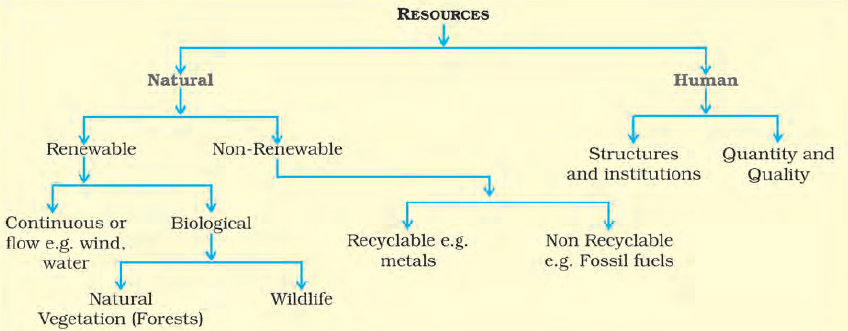Everything available in our environment which can be used to satisfy our needs, provided, it’s technologically accessible, economically feasible and culturally acceptable can be termed as ‘Resource’. Natural endowments in the form of land, water, vegetation and minerals are called natural resources. Resources are materials which can be transformed in such a way that they become more valuable and useful for fulfilling human needs.
Resources can be classified in the following ways:
l On the basis of origin :
(i) Biotic (ii) Abiotic
2. On the basis of exhaustibility :
(i) Renewable (ii) Non-renewable
3 On the basis of ownership :
(i) Individual (ii) Community
(iii) National (iv) International
4 On the basis of status of development :
(i) Potential (ii) Developed
(iii) Stock (iv) Reserves
Resources are compulsory for human survival as well as for maintaining the quality of life.
Human beings use resources indiscriminately and this has led to global ecological crises such as, global warming, ozone layer depletion, environmental pollution and land degradation.
Development of Resources : Resources are vital for human survival. It was believed that resources are free gifts of nature. As a result, man used them indiscriminately which led to the following problems:
- Depletion of resources.
- Accumulation of resources in a few hands.
- Indiscriminate exploitation of resources.
For a sustained quality of life and global peace, it is essential that resources should be distributed equally.
Sustainable economic development means development should take place without damaging the environment and development in the present should not compromise with the needs of the future generation.
Rio de Janeiro Earth Summit, 1992
In June 1992, for achieving sustainable development in the 21st century, more than 100 heads of states participated in the First International Earth Summit in Rio de Janeiro in Brazil. The main focus of this summit was to protect environment and socio economic development at the global level. The leaders of the states signed the Declaration on Global Climate Change and Biological Diversity.
Agenda 21 :
It has been signed by world leaders at the United Nations Conference on Environment and
Development (UNCED). The aim of this agenda is to achieve global sustainable development by combating environmental damage, poverty and disease through global co-operation on common interests, mutual needs and shared responsibilities. The major objective of this agenda is that every local government has the power to draw its own local Agenda 21.
Resource-Planning is a technique of proper utilization of resources.
Resource planning involves the following steps :
- Identification and inventory of resources, which involves surveying, mapping and quantitative as well as qualitative estimation and measurement of resources.
- For implementing resource development plans, evolve a planning structure with appropriate technology,skill and institutional set up.
- Match resource development plan with overall national development plans.
- Resource development and planning reduces wastage, keeps the environment pollution free and takes care of future needs.
- The management of resources by the humans is known as conservation. It is the judicious and planned use of the natural resources.
- Conservation of resources includes a judicious and planned use of resources. Proper exploitation is must, but over exploitation should be checked
India has a variety of relief features like mountains, plateaus and plains. 43% of the country is covered by plains and they provide cultivable land for growing crops. 30% of the country is covered by mountains and they provide
natural resources like forests and wildlife. 27% of the country is covered by plateaus, which contain mineral
resources, forests and some arable land.
Land resources are used for the following purposes:
l Forests
l Land not available for cultivation.
l Other uncultivated land (excluding fallow land)
l Fallow land
l Net sown area
The total geographical area of India is 3.28 million sq km. Land use data, however, is available only for 93% of the total geographical area.
At present there are about 130 million hectares of degraded land in India of which 28% belong to the forest degraded area, 56% of it is water eroded and the rest is affected by saline and alkaline deposits.
The landuse pattern in India is determined by both physical factors such as topography, climate, soil types, human factors such as population density, technological capability, and culture and traditions, etc.
Factors Causing Land Degradation
l Deforestation
l Overgrazing
l Mining and quarrying
l Over irrigation making land saline and alkaline
l Dust generated from cement ceramic industry
l Industrial effluents
Suggestions for Conservation of land
l Afforestation
l Proper management of grazing
l Shelter belts of plants
l Stabilization of sand dunes by planting thorny bushes
l Proper management of wasteland
l Control on mining
l Discharge of industrial effluents and wastes after treatment
SOIL
Soil is the most important renewable natural resource. It is the medium of plant growth and supports different types of living organisms on the earth.
Relief, parent rock or bed rock, climate, vegetation and other forms of life and time are important factors in the formation of soil.
Soil also consists of organic (humus) and inorganic materials.
On the basis of the factors responsible for soil formation, colour, thickness, texture, age, chemical and physical properties, the soils of India can be classified into different types.
India has varied relief features, landforms, climatic realms and vegetation types. These features contributed in the development of various types of soils. They are:
Alluvial soils :
l Widely spread in north Indian plains, alluvial Soils as a whole are very fertile.
l Classified as Khadar (new alluvial) and Bangar (old alluvial).
l Contain adequate proportion of potash, phosphoric acid and lime.
l Ideal for the growth of sugarcane, paddy, wheat and other cereal and pulse crops.
Black soil :
l Also called regur soils. These soils are black in colour.
l Ideal for growing cotton.
l They cover the plateaus of Maharashtra, Saurashtra, Malwa, Madhya Pradesh and Chhattisgarh.
l Rich in soil nutrients, such as calcium carbonate, magnesium, potash and lime, but poor in phosphorus
contents.
l The black soils are made up of extremely fine i.e., clayey material. They are well-known for their capacity to hold moisture.
Red and yellow soils :
l Developed in areas of low rainfall or crystalline igneous rocks.
l Found in Odisha, Chhattisgarh and the piedmont zone of the Western Ghats.
l Due to diffusion of iron in crystalline and metamorphic rocks, its colour becomes reddish.
Laterite soil :
l Develops in areas of high temperature and heavy rainfall.
l Humus content is low.
l Mainly found in Karnataka, Kerala, Tamil Nadu, Madhya Pradesh and hilly areas of Assam and
Odisha.
l Good for tea, coffee, cashew nuts, etc.
Arid soils :
l Sandy in texture and saline in nature.
l Lacks in humus and moisture.
l Found in Western Rajasthan, Punjab and Haryana.
l The lower horizons are occupied by Kankar.
Forest soils :
l Found in hilly and mountainous regions.
l Loamy and silty in valley sides, while coarse grained in the upper slopes.
Soil Erosion :
l The denudation of top soil cover by agents of nature e.g. wind, water and air is called soil erosion.
l Removal of soil due to heavy rainfall and strong wind from one place to another.
l A narrow, steep-sided channels formed in loose earth by running water are called gullies.
l Land unfit for cultivation is known as bad land.
l Human activities that are responsible for soil erosion are deforestation, overgrazing, construction and mining, etc.
Measures for soil conservation :
l Contour ploughing
l Terrace farming
l Strip cropping
l Shelter belts of trees
l Plugging of gullies
l Afforestation
l Control of mining activities









0 Comments